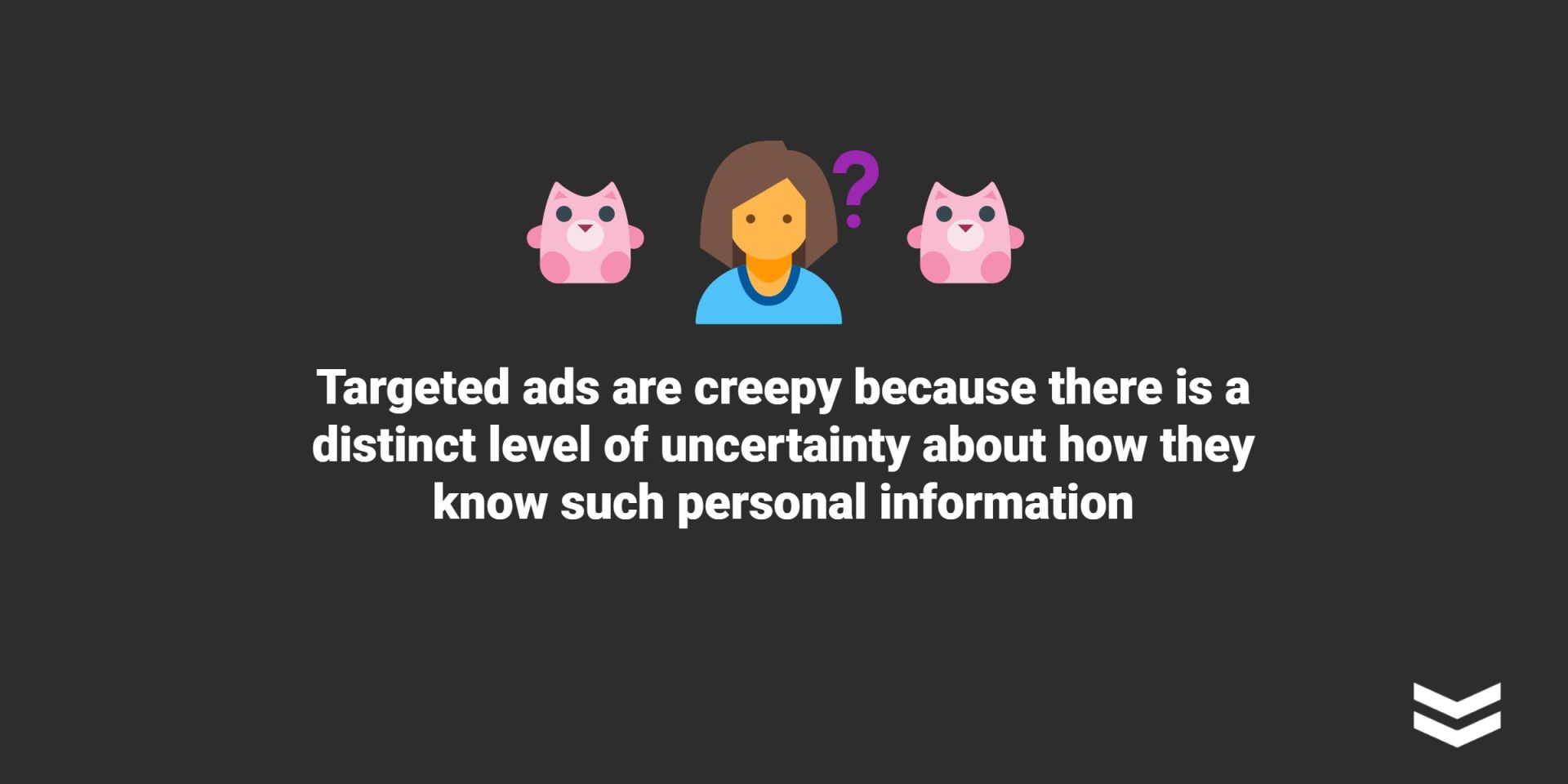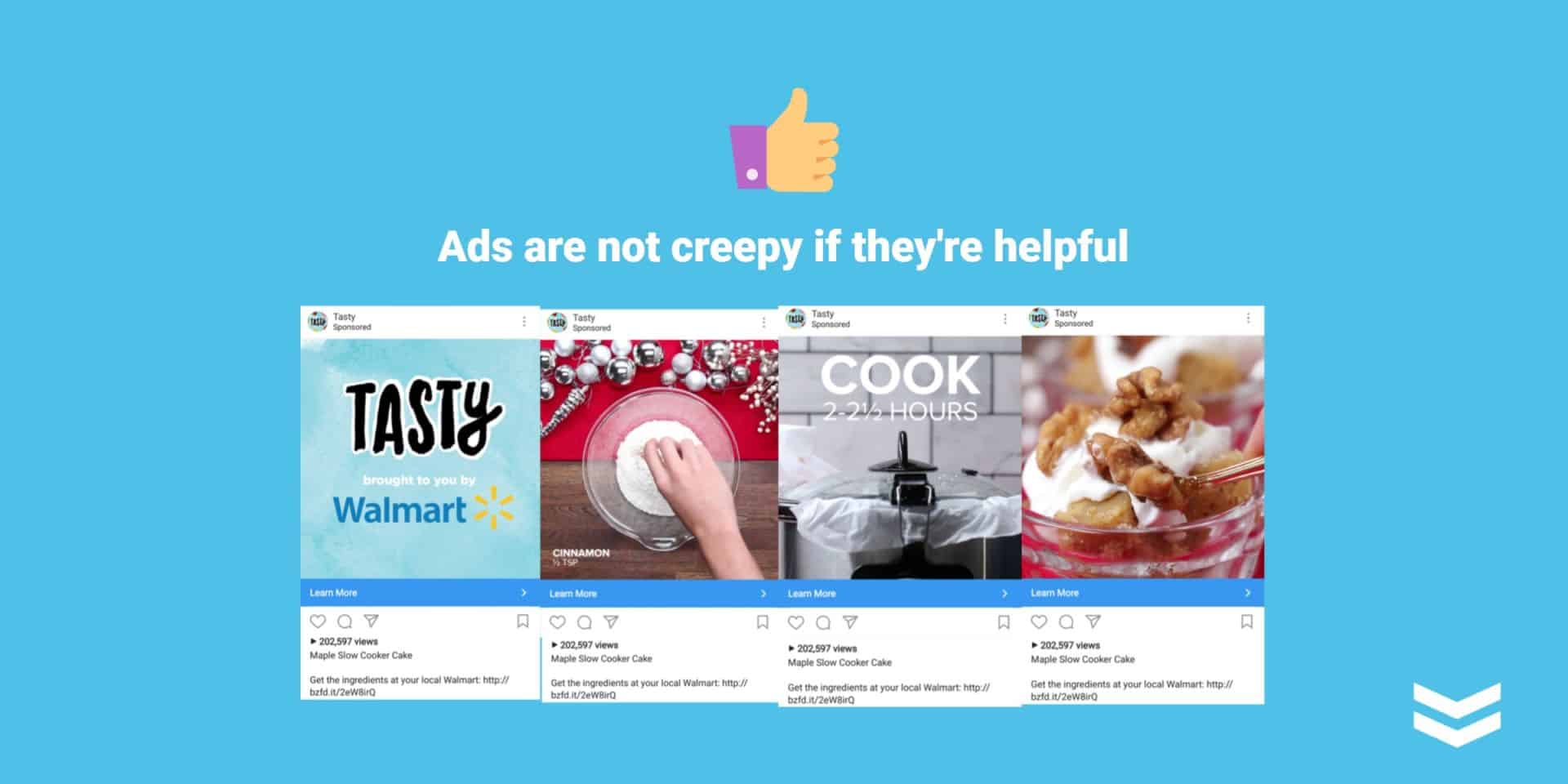Social ad targeting can be creepy. Super creepy.
For a good few years now, advances in targeting technology have given many ads the traits a screenwriter might assign to the lead villain in a horror movie.
These ads follow you around. They seem to know what you like, who you are, and where you’ve been. Targeted advertising has given programmatic media a distinctly clairvoyant quality.
In this post, we delve into the psychology of social ad targeting to investigate what makes an ad creepy, and what makes it constructive. Here’s where to draw the line.
Points we will cover:
Photo by Bret Kavanaugh on Unsplash
The Psychology of Social Advertising
Have you ever spoken about something, and moments later an ad appears offering you the item you mentioned to a friend or family member?
Ads can be so accurate these days that they can alarm, unnerve and startle consumers.
Psychologically speaking, as advertisers, the last thing we want to do is cause negative reactions in our target audiences. They won’t click. They won’t buy. And they’ll uninstall your app.
In extreme cases, people have even deleted Facebook and Google accounts.
According to PR firm Edelman, 4 in 10 people have deleted their accounts over the last 2 years.
There is a movement of people online that are convinced advertisers are listening to their every word – through their smartphones! Is that actually happening?
Let’s look at the facts.
What Makes Social Advertising Creepy?
People don’t like the idea that you’re eavesdropping on them.
If an ad feels intrusive, invasive or too telepathic – it loses its impact. Then public sentiment turns against your brand.
So what makes an advert feel this way?
Psychology Professor Frank McAndrews is an expert on creepiness, and he says it happens because of one thing – the presence of an ambiguous threat.
It comes down to sophisticated targeted advertising, and how consumers don’t really know what it is or how it works. Uncertainty breeds creepiness. Consumers don’t know if there’s a threat here. It’s like looking into the swamp and not knowing if an alligator is there.
Social ad targeting draws from an enormous pool of personal data that has been collected on users – all for the goal of a sale.
The average internet user has no idea how much data they create on a daily basis.
This data is used in relation to their connections, which creates relevance. Such familiarity from a mysterious ad system is perceived by the human brain as threatening.
If a consumer’s child’s birthday is coming up for example, it’s likely that advertisers will know this based on their data, and start to show ads to that person – and that person’s friends – because chances of selling certain items are that much higher, at that time.
Now imagine if that child gets 2 of the same toys at their party. Later that day, mom is browsing Facebook, and sees that exact toy advertised to her.
She hasn’t taken any photos, or spoken about it via text – or posted anything on any social media platforms. But there is the toy her son was given by two of her friends.
“How is that possible? How did they know?”
The uncertainty sends shivers down her spine. She feels like she’s being watched.

- Ad frequency is too high
- Real-time ads show at accurate times
- The same ad is shown to people who know each other
- Ads follow you around (retargeting)
- Ads interrupt other media
Are Advertisers Listening in on Me?
There are thousands of people online who will swear Facebook and other social ad platforms are listening to them every day.

But it’s not true. It’s not impossible, but the logistics alone make very little sense.
Here’s why:
#1: It’s Illegal
It’s illegal for social ad platforms like Facebook, Google or anyone to listen to your private voice conversations without your knowledge.
#2: Public Denial
Facebook and other social networks have publically denied using your phone microphone to listen to your conversations.
#3: Too Much Data
Listening in to a few billion people’s phone conversations would be a logistical nightmare. Storing and sorting through this data alone would be resource intensive.
#4: There is No Need
What Makes Social Advertising Constructive?
There are bad ads, and good ads. The general consensus among savvy advertisers is that they want their consumers to like their ads. This means you need to be deliberately un-creepy.
Things like Twitter ad targeting and Youtube ad targeting need to be done with consumer uncertainty in mind. People aren’t just commodities, they have doubts and fears.
Creepy targeted ads aren’t going to go away. As advertisers, we can work to make our messages less invasive, genuinely helpful, and not misleading to click on.
We can build certainty and clarity into our campaigns.
We can work to educate and entertain our consumers by telling stories, as opposed to bombarding them with hard-sell social ads that cause irritation and won’t go away.
Here’s how to make constructive ads:
- Emotional stories
- Educational value
- Ads that connect people
- Ads that entertain
- Ads that give consumers genuine deals
This example from Walmart ticks the boxes. The ads are helpful, educational and highly entertaining. They’re not just selling, they’re brand-building and creating true value for the viewer.

People have the brands they love. It’s not that they don’t want to see any ads, they just don’t want to feel like they are being watched – like a deer in an open field.
This rings incredibly true especially in 2020, because of the pandemic. In our Holiday Marketing Tips for 2020 blog, it’s important to show consumers you care and can offer value instead of being in their face about selling.
It’s pretty clear that the responsibility is on you, the brand advertiser, to make sure that your ads are helpful and enjoyable to your customer base – so that ‘creepy’ is never a word used to describe your ads. There are so many creepy ads out there, and you don’t want yours to be part of that group.
Social ad targeting is only going to become more refined in future years. As programmatic technology improves, so must the ads being used to convert users into paying customers. And that means taking a smarter approach to relevance, timing and placement online.
Check out these programmatic ad examples for more inspiration.
What Have We Learned?
People are creeped out by social ad targeting because it’s as if advertisers can predict their thoughts. They worry about the invasion of privacy.
Psychologically speaking, this fear is due to the presence of an ambiguous threat. Consumers don’t understand how highly-targeted advertising works–they don’t know how much data they create on a daily basis. It’s estimated that 1.7 MB of data is generated for every single person on the planet in every second!
Most reasons ads come off as creepy:
Too high of a frequency
Real-time ads shown at accurate times
Friends and family come across the same ad
Retargeting ads that “follow” people around online
Ads that interrupt when in use of another media
Some people fear that their big tech companies are monitoring them through their phones. Actually, there is no need because people generate enough user data through real-time, behavior and social connections.
To create good social ads, here are some ways to succeed: create emotional connections, entertain and/or educate your audience!
People prefer ads that are tailored to their interests and lifestyle.
Remember: it’s not just about selling, it’s about establishing your brand as trustworthy and reliable.













